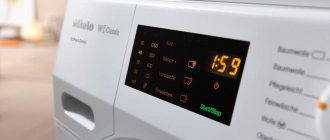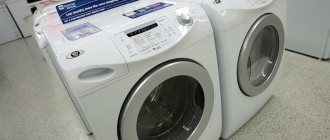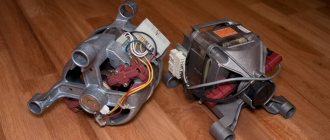Relatively recently, dishwashers appeared in the homes of our compatriots. This device is appreciated not only by women, but also by men, because they have a lot of free time.
But even today, many people have many questions on various topics related to dishwashers. Common questions include questions about the method of loading dishes. Information on the correct installation of the device to the water supply system is also urgently needed. Many people believe that it is better to connect the dishwasher directly to hot water. After all, the electricity tariff increases almost every day, and yet there is always hot water in the tap. Why use electricity to heat water for your dishwasher?
Many experts answer the question ambiguously: “Is it possible to quickly and reliably connect a dishwasher to hot water?” After all, not all manufacturers can give clear recommendations on this matter.
Connection
Of course, there are many models that can be connected to a water supply. But all users must strictly follow the recommendations and rules specified in the instructions for the device.
If you decide to connect your dishwasher directly to hot water, you should prepare a special fill hose. If a regular hose is installed, this can lead to serious consequences.
Please note that all water supply hoses must be marked red and blue. This way the consumer can recognize the values at any time.
Advantages of connecting a dishwasher to hot water
Many experts agree with the opinion of thrifty consumers. Therefore, they cite their advantages of connecting the dishwasher to warm water.
This connection method significantly reduces energy consumption in the house. After all, the device washes cutlery at high temperatures. The final rinse of the dishes is also carried out with the same thermal water, which has a beneficial effect on their drying.
The washing process is much faster, because no time is wasted on heating the water in the tank.
The heating element in the device wears out more slowly, because it practically does not need to be used.
But, at the same time, many experts do not understand why, if there is hot water in the house, it is impossible to use a sink. After all, this reduces the consumption of both water and electricity to a minimum.
In addition, many manufacturers recommend using cold water for connection.
Disadvantages of connecting a dishwasher to hot water
Many experts recommend paying attention to the water temperature. If it exceeds 600C, this may adversely affect the built-in filtration system. All damaged flow filter meshes will quickly fail, which means they will need to be changed regularly. But you cannot use the device without filters, because debris will end up in the dishwasher.
Hot water pressure is different from cold water. The difference between these indicators increases significantly if we consider that hot water enters the device through a cylinder in the boiler.
Hot water carries more debris, so additional filters should be used.
Kinks and kinks are more likely to appear on water hoses designed for high-temperature water. Therefore, before installation, you should check whether the hose is under any physical stress. In this case, the hose may soften and rupture when water passes through it.
High temperature water also negatively affects the drain hose and pipes of the machine. This reduces its service life.
Sometimes hot water can “stick” food to the surface of the plate during the first wash. And this will significantly complicate the process of cleaning dishes.
Everyone knows that problems with hot water supply occur much more often than with cold water. Suffice it to remember the summer (the time of repair and maintenance work), when the period of shutting off hot water can be very long.
Often in dishwashers the wash cycle takes place at a temperature of 500C. If water arrives at a temperature of 60 degrees, this program may not be completed. After all, a dishwasher can heat water, but not cool it.
The reasons why your dishwasher may not heat the water can be found here.
Features of connecting to hot water
The device is connected to hot water according to the same principle as to cold water. But such installation requires a number of features. So, how to properly connect a dishwasher to the water supply?
- Read the instructions for the device carefully. Make sure that the device is connected to hot water supply. After all, for example, for Bosh models, the water temperature should not exceed 200C, which means you need to use only cold water.
- Prepare a special inlet hose designed for hot water.
- Install the in-line filter. It will additionally protect the dishwasher from hot water impurities. Install it between the pipe outlet and the inlet hose.
Before you begin connecting the device, you should assemble all the components. The hot water inlet hose must be of high quality. Some manufacturers supply a similar hose with a dishwasher designed for such a connection.
Prepare a tee valve. It must be used to connect the machine. In addition, it will help shut off the water supply if necessary.
So, you need to prepare:
- hose;
- cleaning filter;
- special mixer;
- brass tee with shut-off valve;
- fum tape and wrench.
Recommendations for individual installation operations
The work on installing the PMM also includes leveling the position of the machine using adjusting screws. Two of them are located in the front of the body, one is located in the back. Built-in models are secured in the opening using bushings and screws. Tips to help you connect correctly and extend the trouble-free operation of your dishwasher:
- installing a drain hose in a sink may risk flooding your neighbors; if the hose falls out of the sink, it is better to connect it through a siphon;
- the grounding wire from the PMM socket is connected to the bus of the same name on the apartment panel - it is prohibited to ground the machine to gas, heating, or water pipelines;
- the gap between the wall and the back panel of the device must be ≥5 cm to ensure air circulation;
- Electrical sockets for each high-power household appliance: stove, washing machine, PMM must have a separate connection to the apartment panel so that there is no overload in the electrical network.
The device comes with a user manual, which includes connection instructions. Each PMM model is individual, but the recommendations are general.
Connecting the dishwasher to hot water
To supply hot water to the dishwasher, you do not need to use special tools. You can easily screw the hose to the dishwasher yourself, using only hand strength. Well, for reliable installation of the tee tap, you should use an adjustable wrench. Remember that the fum tape must be wound in the direction against the thread. It is necessary to make about 10 revolutions.
So, the connection sequence is:
- We remember about safety, so we turn off the water. Otherwise, you may be scalded by boiling water.
- The plug must be removed from the water pipe.
- There is a thread at the end of the pipe outlet. Do not wrap fum tape or tow on it.
- Screw on the brass tee. We check whether the joints are tightly connected.
- We screw a fum tape onto one terminal of the tee and tightly screw the end of the inlet hose. We check that it can easily reach the device body.
- We install a plug on the second terminal of the tee.
- And install the flow filter at the other end of the hose
- We attach this entire structure to the filling valve of the device.
Upon completion of all work, you should open the water and check the tightness of all connections. If everything is in order, you can test the operation of the device.
e4 flashes on the dishwasher display - you can read what this means in our article.
How to connect correctly
You can connect the water supply system to the dishwasher yourself. To do this you will need the following set of tools and consumables:
- Set of wrenches.
- Adjustable wrench.
- FUM tape.
- Screwdrivers.
- Hose.
- Filter.
- Tee.
There are several different connection options. If the repair is carried out taking into account the possibility of installing a dishwasher, then a branch is made for it. The recommendations are as follows:
- The filter element is installed. It significantly increases the service life of the equipment.
- A flexible hose is used to directly connect the system. Its connection is carried out using special adapters, the thread is insulated with FUM tape.
- It is recommended to place a ball valve in front of the PMM. It is used in case of system maintenance.
- After connecting the hose, attention is paid to the degree of sealing of all connections. To do this, the tap is opened and one of the available programs is launched.
When installing equipment, care must be taken to ensure that it is positioned strictly vertically. A deviation of even 2° can cause the system to malfunction.
Source: tehno.expert
Other connection options
Often, in expensive models of dishwashers, it is possible to connect the device to water in 3 ways:
- to hot;
- to cold;
- simultaneously to 2 sources.
It is the latter method that is especially popular. Thanks to it, equipment can independently mix 2 streams of water to the required temperature. This way you can not only save energy, but also choose the desired washing mode.
But this method involves the use of a large number of hoses. And this does not always look aesthetically pleasing and is far from inconvenient to connect.
Using a siphon and mixer for adjoining
Proximity to the sink is the easiest way to start the dishwasher. There is no need to lay pipelines, the number of alterations is reduced to a minimum. For new houses, such a supply of communications is the rule. To connect household appliances the following are equipped:
- A socket with grounding, designed for the power of washing machines and PMMs.
- Siphon with two additional outlets - for SMA and dishwasher.
- A tee on a cold pipe under the sink with taps and three fittings: 1 for the mixer, 2 for household appliances.
When such equipment is not available, additional plumbing fixtures are installed independently.
Traditional dishwasher connection
Almost all dishwashers are designed to be connected to cold water. This is stated in the instructions for the device, which indicates a clear sequence for installing kitchen equipment.
It is strictly forbidden to connect the device to hot water if this possibility is not indicated in the product data sheet. Remember, you should take into account all the features and recommendations of the manufacturer.
So, it is generally accepted that the traditional way to install the device is in cold water. The sequence of work is practically no different from connecting to hot water.
- Turn off the water supply tap;
- Use a wrench to unscrew the mixer nut and release the thread of the pipe.
- Fum tape or tow is wound.
- A tee is installed. At the same time, we take into account that the side outlet is in a convenient position for connecting the hose to the dishwasher.
- We install the mixer.
- Turn the tap on the tee to the “closed” position. We open the general water supply and check the tightness of the joints.
- Install the dishwasher hose by screwing on the plastic nut
Conclusion
A dishwasher is an indispensable device in every modern home. Correct installation guarantees long-term operation of the device. Should I connect the device to hot water? A definite answer cannot be given, because there are many arguments both for and against. The manufacturer can judge everyone. After all, it is he who indicates in the product passport all the recommendations for its installation.
Remember, you should think carefully several times before installing the device without paying attention to the recommendations specified in the instructions. This can harm not only the dishes, but also the equipment.
So, which water is better to connect the dishwasher to (cold or hot) is up to the owner of the device to decide. Everything depends only on his preferences and desires. But as practice shows, the main advantage of hot water supply (reducing energy costs) does not turn out to be such. Especially if you take into account the possibility of possible breakdowns of the device and inconvenience in its operation.
Find out what to do if E14 flashes on the dishwasher display in our article.
Determining the location for the PMM
Before buying a kitchen assistant, you should evaluate the possibilities of the room and find a place to place a new household appliance. There are desktop and floor-standing models, built-in, built-in and free-standing types of machines, respectively, you can choose the most suitable option. We reviewed the best models of Bosch brand dishwashers in the following material.
You need to completely abandon the purchase only if the kitchen is small and every centimeter of usable space is already occupied.
Usually the dishwasher is placed in the lower tier of furniture, not far from the sink. The connection location is dictated by the location of sewer and water supply communications. The closer the machine is to the pipes, the fewer problems there are with installing and connecting a Bosch dishwasher, regardless of its technical characteristics.
Image gallery
Photo from
Compact desktop machines – minimum space
Freestanding dishwasher
Built-in models 60 cm wide
Built-in narrow machines 45 cm
Do not forget that any saving is a concession. Suppose, narrow built-in dishwashers easily process serving sets - plates, cutlery, cups, provided they are loaded correctly, but some models are not suitable for washing pots, baking sheets, baking dishes, frying pans. And housewives in large families know well how much time and effort goes into cleaning large-sized dishes.











